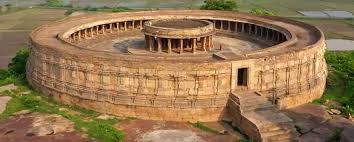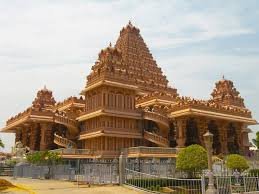Introduction
India is home to several ancient temples that hold deep spiritual and historical significance. Among these, the Chausath Yogini Temples in Morena and Khajuraho stand out as remarkable examples of Tantric architecture and Shakti worship. These temples, dedicated to the 64 Yoginis, symbolize the divine feminine power . read more about Chausath Yogini Temple.
Located in Madhya Pradesh, these temples date back to the 9th–10th century and are among the few surviving Yogini temples in India. Their unique circular architecture, open-air sanctums, and spiritual aura make them fascinating sites for history enthusiasts, devotees, and travelers alike.
Let’s explore the rich history, architectural marvels, and spiritual significance of these two magnificent temples.
The Legend of Chausath Yoginis
The term “Chausath Yogini” refers to the 64 divine female deities, who are believed to be manifestations of Goddess Durga or Kali. In Tantric traditions, these Yoginis represent various aspects of cosmic energy and are associated with mysticism, supernatural powers, and esoteric knowledge.
According to legend, these Yoginis were celestial warriors who assisted Devi Durga in her battles against demons.
Why Are Chausath Yogini Temples Unique?
Unlike traditional Hindu temples, Yogini temples are typically circular or open-air shrines. The absence of roofs signifies an unrestricted connection with the cosmos, allowing divine energy to flow freely. This makes these temples ideal for Tantric meditation and sadhanas (spiritual practices).
Chausath Yogini Temple – Morena
Historical Significance
Situated in Mitawali village of Morena district, the Chausath Yogini Temple of Morena is believed to have been built around 1323 AD by the Kachchhapaghata rulers. Some historians suggest that this temple inspired the architectural design of the Indian Parliament House, owing to its striking circular structure.
Architectural Marvel
The Morena Chausath Yogini Temple is an architectural masterpiece that showcases the brilliance of ancient Indian craftsmanship.
- Circular Layout – The temple is built in a perfect circular form, measuring 170 feet in diameter.
- Central Shrine – At the center stands a temple dedicated to Lord Shiva, housing a Shiva Lingam.
- Stone Construction – Made entirely of local sandstone, the temple has withstood centuries of natural wear and remains a testament to ancient engineering skills.
Spiritual Significance
The Chausath Yogini Temple in Morena is revered as a powerful energy center where seekers meditate to attain spiritual awakening. The open-air design and cosmic alignment make it an ideal place for Tantric practices, astrology, and divine connection.
- Devotees visit to seek blessings for wisdom and strength.
- Scholars believe that ancient sages performed astronomical calculations here.
- Many believe that the temple’s energy field enhances spiritual consciousness.
Chausath Yogini Temple – Khajuraho
Historical Background
The Chausath Yogini Temple in Khajuraho is the oldest surviving structure in the Khajuraho temple complex. Built around 875–900 AD by the Chandela dynasty, this temple marks the beginning of Khajuraho’s architectural brilliance.
Unlike other ornate and sculpted temples in Khajuraho, this one features a simplistic yet powerful design, signifying its esoteric nature.
Architectural Distinction
The Khajuraho Chausath Yogini Temple stands on a raised platform and consists of 64 small chambers, each originally housing a Yogini idol.
- Rectangular Layout – Unlike the circular temple in Morena, this one has a rectangular shape, making it unique among Yogini temples.
- Minimal Ornamentation – The temple’s plain sandstone walls suggest its functional purpose as a place for Tantric rituals rather than elaborate worship.
- Surrounding Beauty – The temple’s location offers a scenic view of the Khajuraho landscape, adding to its mystical charm.
Spiritual Relevance
This temple is considered a center of divine feminine energy and holds deep significance for Tantric worshippers. The original 64 Yogini idols are no longer present, but the temple remains a sacred site for meditation.
- Devotees visit to connect with the divine feminine force
- Many consider it a gateway to higher consciousness and self-discovery.
Why You Should Visit These Temples
Visiting the Chausath Yogini Temples in Morena and Khajuraho is a transformative experience, offering a blend of history, spirituality, and architectural brilliance.
1. Experience Ancient Tantric Traditions
Both temples hold a mystical aura, making them ideal for those interested in yoga, meditation, and Tantra.
2. Witness Unique Temple Architecture
The circular and rectangular layouts, along with the open-air concept, make these temples one-of-a-kind architectural wonders.
3. Explore India’s Rich Heritage
The temples reflect India’s deep-rooted traditions, showcasing the artistic and spiritual achievements of ancient civilizations.
4. Connect with Cosmic Energy
Whether you are a devotee or spiritual seeker, the temples provide an opportunity to experience divine energy and inner peace.
Best Time to Visit
The best time to visit these temples is between October and March, when the weather is pleasant. Early mornings or evenings are ideal for a peaceful and immersive experience.
- Timings: 6:00 AM – 6:00 PM
- Entry Fee: Free
- Nearest Airports: Gwalior (for Morena) & Khajuraho (for Khajuraho temple)
- Best Route: Taxis and buses are available from major cities like Gwalior, Jhansi, and Bhopal.
Conclusion
The Chausath Yogini Temples of Morena and Khajuraho stand as silent sentinels of India’s mystical past, preserving the secrets of Tantric worship, divine energy, and ancient architecture.
These temples are not just historical landmarks; they are portals to spiritual awakening, offering visitors a chance to connect with higher realms of consciousness.





